RedNeckGeek
Super Member
- Joined
- Jan 1, 2011
- Messages
- 8,746
- Location
- Butte County & Orcutt, California
- Tractor
- Kubota M62, Kubota L3240D HST (SOLD!), Kubota RTV900
This is the fourth installment on the Ariens 22 ton log splitter I purchased a few months back. I'll cover it's use in preparing firewood for the coming winter and talk a little about issues and tips that I've come across. I've gone through almost all of the wood I have on the ground and ended up somewhere shy of ten cords of mostly oak stacked on simple racks made from pallets. The splitter has handled everything I've thrown at it: oak rounds up to 18" in diameter, lots of crotches, even some stumps. Some of the pieces were pretty tough, but only once did I have to pry a piece off the wedge when the built in stripper plates flexed wide enough to let the wedge fully retract before the wood was pushed off. That was more my fault than the splitter's, as I tried to split a 15" oak round in the middle instead of off to one side or into an existing crack. Once the round was free it split easily when I took smaller bites.
I changed the engine oil after splitting three or four cords; the drain on the Subaru engine did let oil drip on the mounting platform, but it didn't take much to clean up the mess. The engine has not used a drop of oil since. So far it always starts with just one or two pulls on the cord, even when I run the fuel tank dry. Most days this summer have been in the 80s, so I can't say how easy it'll start in freezing weather.
I've noticed a slight weeping of hydraulic oil from one or two fittings, and around the filler plug/dip stick on the tank. Probably just need a little tightening, but there's so little oil I'll wait 'till I put it away for the winter. The only other problem is that the housing for the splitter valve came loose from the top of the cylinder. It's not a hydraulic joint and simply tightening the jamb nut took care of the problem.
I was getting some rattling from the pin that secures the rear stabilizer, but silenced it with a washer of rubber hose jammed between the splitter frame and the cotter key. The rounds I'm splitting aren't heavy enough to warrant using the stabilizer so I haven't had to fool with it since. The muffler is loud enough that I use either ear plugs or muffs, and it would be nice if it was quieter. But since I usually wear in-ear buds and an iPod to listen to audio books or music, it really doesn't matter.
In the last installment, I mentioned that the splitter arrived at Home Depot with no hydraulic oil and missing a nut for the trailer hitch. I called and web chatted with Ariens tech support, who promised to send the missing oil and nut. But here we are months later and nothing's shown up on my door step. Even though I was able to find the oil for sale locally and dig a spare nut out of my junk drawer, it doesn't say much for the tech support guys I spoke with. I got the feeling they'd say anything I wanted to hear just to get on to their next phone call. I hope I don't have any serious problems where they'd actually have to help me fix it, as the closest dealer is about 75 miles away.
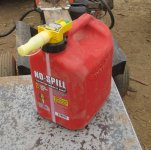
So far all the splitting I've done has been with the beam horizontal, and the height is very comfortable to use. I can stand up straight, easily reach the splitter valve, and spend very little time picking up wood off the ground thanks to the table (more on that in a minute). A tank of gas lasts an hour and a half or close to two hours, and that's about as long as I like to work at a stretch without a break anyway. At first I was using a five gallon can for refueling, but the gas came out too fast and the can was very heavy when full. I picked up a two gallon "No Spill" can and haven't spilled a drop since. It will refill the splitter a half dozen times, easily two covering two days of work.
I've also learned that some logs will throw splits to the side quite vigerously, and will step back behind the wedge when it starts to bog down. That's usually with crotches and stumps, and sometimes logs that were shattered by the bulldozer. The teeth on the beam foot to a great job of hanging onto the log, but I've also learned to keep the flattest end of the log on the teeth to prevent that end from skidding up and out as the wedge advances. Same with arched and twisted wood, always making sure at least some teeth are engaging on that end. And I try never to stand over the wood as the wedge advances as I've had a couple pieces jump high into the air instead of splitting. I also keep my hands on the sides of the log and try never to place them on either end where they could get pinched by the foot or wedge. So far Cabela's elk skin gloves seem to hold up the best, but a hole will usually show up in a finger tip after seven or eight tanks of fuel while handling the rough splits. Deer skin wears out even more quickly, so I'd like to find something less expensive that would last longer. Anyone have any recommendations?
I haven't found power to be a problem for the wood I have. Most of it has been oak that's been on the ground for a couple years or more, usually in the 6"-10" diameter range. Usually the wedge advances without slowing, but when it hits a lot of twisted or cross grain, the pump will down shift and keep right on going. That slows the process a little bit, but not much, and I still spend more time moving wood onto and off the rail than waiting for the ram. I've also split a fair amount of manzanita, again well dried, and it is very easy to split. The toughest wood has been from an oak tree that blew down last winter and measured in the 20% moisture range. That wood liked to tear rather than split, and was difficult to get straight splits. Even so there was enough power to shear the wood and I still ended up with useable splits.
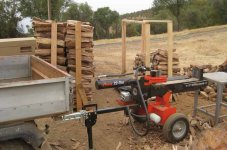
I store the splitter in a twenty four foot box trailer with a drop down door/ramp in the back, and use a Kubota RTV900 to back it up the ramp and haul it to the wood lot. The ground has lots of slope along the way and I've been very pleased that the splitter hasn't once tried to tip over (unlike the concrete mixer when towed over the same rough tracks). The two inch hitch matches the ball on the Kubota and also the rest of my trailers, and I like not having to swap just to tow the splitter.
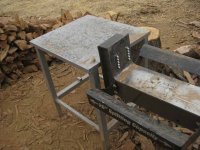
I found some square tubing and sheet steel at the scrap yard a few months back and welded up a small table to hold splits as they came off the wedge. The log cradles do a good job of keeping a round centered and of catching larger splits as they come off, but they're not big enough to hold pieces that need to be split again. I set the table up off the end of the rail so all I have to do is flip the split over and it lands on the table. The table is just big enough to stack all the splits from an 18" round, it's light enough to pick up and easily move ,and it's strong enough that I can jump up and down on it and not feel any flexing. A coat of silver Rustoleum hammer finish keeps it from rusting and hides my ugly welding and grinding marks.
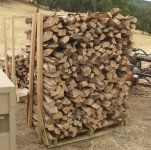
The local tile store has plenty of wood pallets and they're very happy when I take as many as will fit in my truck. I like to use the 40" x 48" size, and once home use drywall screws to mount two five foot tall frames across the long direction. It's not a very sturdy arrangement, but it's good enough to keep the splits off the ground and let me move them with the forklift attachment on the FEL of the tractor. I like to set the pallet up behind me at the splitter so all I have to do is turn around with the splits and drop them onto the pallet. Each one holds just shy of half a cord, and that's about all the weight the FEL will lift, so it all works out nicely. I picked up some industrial stretch plastic wrap at Harbor Freight (gotta love those 20% off coupons) and put a couple turns around the top of a full rack to keep the wood from slipping when it's being moved.

I get lots of chips when splitting so I started gathering them up for kindling. I found an old beat up Knaack job box on Craig's list, knocked the dents out, fixed the hinge, welded up the extra holes, and gave it a coat of house paint. It's now full of kindling, as is a 40 gallon plastic garbage can. Those will sit on the back porch next to the door closest to the wood stove.
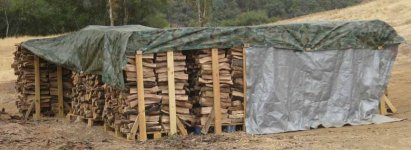
There are still three or four bus sized wood piles left on the property, but after splitting and racking about ten cords I think I'll have enough to get through the winter. We don't get many days where the lows dip into the 20s and it's usually at least 50F during the day, so I'm probably going to be able to get by with a fire in the morning and maybe another in the evening when things cool off. With a well insulated house and plenty of southern exposure the sun should do the rest. About all that's left now is some clean up on the gravel pad where the wood will stay for the winter, then use the tractor to move it all over there. A plastic tarp from Harbor Freight just about covers the twenty or so pallets, and I have some 5'x7' freebie tarps to take care of any that don't fit. Once we get closer to the rainy season I'll use the plastic wrap to fully wrap the racks and keep the wood dry, and once I start burning I'll drop mouse bait in a rack before I fork each pallet into the garage as needed. Once the weather cools off and I have a supply of empty pallets, I'll start dragging wood out of the piles and start the whole process again, taking advantage of the whole summer for drying out the wood.
All in all I'm very happy with the Ariens 22 ton splitter, and glad I didn't spend the extra money for the heavier 27 ton version. It's easy to move by hand, trailers well, fits into the back of my pickup under the camper shell, and so far has done everything I've asked of it. If I had it to do over again, I think I'd buy another one.
I changed the engine oil after splitting three or four cords; the drain on the Subaru engine did let oil drip on the mounting platform, but it didn't take much to clean up the mess. The engine has not used a drop of oil since. So far it always starts with just one or two pulls on the cord, even when I run the fuel tank dry. Most days this summer have been in the 80s, so I can't say how easy it'll start in freezing weather.
I've noticed a slight weeping of hydraulic oil from one or two fittings, and around the filler plug/dip stick on the tank. Probably just need a little tightening, but there's so little oil I'll wait 'till I put it away for the winter. The only other problem is that the housing for the splitter valve came loose from the top of the cylinder. It's not a hydraulic joint and simply tightening the jamb nut took care of the problem.
I was getting some rattling from the pin that secures the rear stabilizer, but silenced it with a washer of rubber hose jammed between the splitter frame and the cotter key. The rounds I'm splitting aren't heavy enough to warrant using the stabilizer so I haven't had to fool with it since. The muffler is loud enough that I use either ear plugs or muffs, and it would be nice if it was quieter. But since I usually wear in-ear buds and an iPod to listen to audio books or music, it really doesn't matter.
In the last installment, I mentioned that the splitter arrived at Home Depot with no hydraulic oil and missing a nut for the trailer hitch. I called and web chatted with Ariens tech support, who promised to send the missing oil and nut. But here we are months later and nothing's shown up on my door step. Even though I was able to find the oil for sale locally and dig a spare nut out of my junk drawer, it doesn't say much for the tech support guys I spoke with. I got the feeling they'd say anything I wanted to hear just to get on to their next phone call. I hope I don't have any serious problems where they'd actually have to help me fix it, as the closest dealer is about 75 miles away.

So far all the splitting I've done has been with the beam horizontal, and the height is very comfortable to use. I can stand up straight, easily reach the splitter valve, and spend very little time picking up wood off the ground thanks to the table (more on that in a minute). A tank of gas lasts an hour and a half or close to two hours, and that's about as long as I like to work at a stretch without a break anyway. At first I was using a five gallon can for refueling, but the gas came out too fast and the can was very heavy when full. I picked up a two gallon "No Spill" can and haven't spilled a drop since. It will refill the splitter a half dozen times, easily two covering two days of work.
I've also learned that some logs will throw splits to the side quite vigerously, and will step back behind the wedge when it starts to bog down. That's usually with crotches and stumps, and sometimes logs that were shattered by the bulldozer. The teeth on the beam foot to a great job of hanging onto the log, but I've also learned to keep the flattest end of the log on the teeth to prevent that end from skidding up and out as the wedge advances. Same with arched and twisted wood, always making sure at least some teeth are engaging on that end. And I try never to stand over the wood as the wedge advances as I've had a couple pieces jump high into the air instead of splitting. I also keep my hands on the sides of the log and try never to place them on either end where they could get pinched by the foot or wedge. So far Cabela's elk skin gloves seem to hold up the best, but a hole will usually show up in a finger tip after seven or eight tanks of fuel while handling the rough splits. Deer skin wears out even more quickly, so I'd like to find something less expensive that would last longer. Anyone have any recommendations?
I haven't found power to be a problem for the wood I have. Most of it has been oak that's been on the ground for a couple years or more, usually in the 6"-10" diameter range. Usually the wedge advances without slowing, but when it hits a lot of twisted or cross grain, the pump will down shift and keep right on going. That slows the process a little bit, but not much, and I still spend more time moving wood onto and off the rail than waiting for the ram. I've also split a fair amount of manzanita, again well dried, and it is very easy to split. The toughest wood has been from an oak tree that blew down last winter and measured in the 20% moisture range. That wood liked to tear rather than split, and was difficult to get straight splits. Even so there was enough power to shear the wood and I still ended up with useable splits.

I store the splitter in a twenty four foot box trailer with a drop down door/ramp in the back, and use a Kubota RTV900 to back it up the ramp and haul it to the wood lot. The ground has lots of slope along the way and I've been very pleased that the splitter hasn't once tried to tip over (unlike the concrete mixer when towed over the same rough tracks). The two inch hitch matches the ball on the Kubota and also the rest of my trailers, and I like not having to swap just to tow the splitter.

I found some square tubing and sheet steel at the scrap yard a few months back and welded up a small table to hold splits as they came off the wedge. The log cradles do a good job of keeping a round centered and of catching larger splits as they come off, but they're not big enough to hold pieces that need to be split again. I set the table up off the end of the rail so all I have to do is flip the split over and it lands on the table. The table is just big enough to stack all the splits from an 18" round, it's light enough to pick up and easily move ,and it's strong enough that I can jump up and down on it and not feel any flexing. A coat of silver Rustoleum hammer finish keeps it from rusting and hides my ugly welding and grinding marks.

The local tile store has plenty of wood pallets and they're very happy when I take as many as will fit in my truck. I like to use the 40" x 48" size, and once home use drywall screws to mount two five foot tall frames across the long direction. It's not a very sturdy arrangement, but it's good enough to keep the splits off the ground and let me move them with the forklift attachment on the FEL of the tractor. I like to set the pallet up behind me at the splitter so all I have to do is turn around with the splits and drop them onto the pallet. Each one holds just shy of half a cord, and that's about all the weight the FEL will lift, so it all works out nicely. I picked up some industrial stretch plastic wrap at Harbor Freight (gotta love those 20% off coupons) and put a couple turns around the top of a full rack to keep the wood from slipping when it's being moved.

I get lots of chips when splitting so I started gathering them up for kindling. I found an old beat up Knaack job box on Craig's list, knocked the dents out, fixed the hinge, welded up the extra holes, and gave it a coat of house paint. It's now full of kindling, as is a 40 gallon plastic garbage can. Those will sit on the back porch next to the door closest to the wood stove.

There are still three or four bus sized wood piles left on the property, but after splitting and racking about ten cords I think I'll have enough to get through the winter. We don't get many days where the lows dip into the 20s and it's usually at least 50F during the day, so I'm probably going to be able to get by with a fire in the morning and maybe another in the evening when things cool off. With a well insulated house and plenty of southern exposure the sun should do the rest. About all that's left now is some clean up on the gravel pad where the wood will stay for the winter, then use the tractor to move it all over there. A plastic tarp from Harbor Freight just about covers the twenty or so pallets, and I have some 5'x7' freebie tarps to take care of any that don't fit. Once we get closer to the rainy season I'll use the plastic wrap to fully wrap the racks and keep the wood dry, and once I start burning I'll drop mouse bait in a rack before I fork each pallet into the garage as needed. Once the weather cools off and I have a supply of empty pallets, I'll start dragging wood out of the piles and start the whole process again, taking advantage of the whole summer for drying out the wood.
All in all I'm very happy with the Ariens 22 ton splitter, and glad I didn't spend the extra money for the heavier 27 ton version. It's easy to move by hand, trailers well, fits into the back of my pickup under the camper shell, and so far has done everything I've asked of it. If I had it to do over again, I think I'd buy another one.
Last edited:
